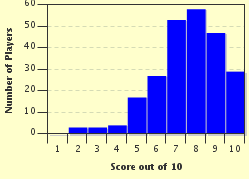Quiz Answer Key and Fun Facts
1. Which of these is another term for back pain?
2. The back is made up of several structures which include muscles, bones, joints and nerves. Damage to any of these structures singly or in combination can result in back pain.
3. Anatomically, the spine is divided into several sections. Which of these sections is MOST often affected in people with the complaint of backache?
4. Which of these statements regarding backache is INCORRECT?
5. Which of these groups of people is LEAST susceptible to back pain?
6. When is backache considered chronic?
7. Several things can be done to prevent or reduce back pain. Which of these is NOT one of them?
8. Which of these activities is most likely to result in backache?
9. When treating acute back ache, which of the following measures is LEAST helpful?
10. Able-bodied Mr Big is a friendly, cooperative unit secretary at a local hospital. One day, a nurse sought his help in transferring a 500 pound patient to a spacious bed. While doing this good deed, Mr Big injured his back and was out of work for a while. Consider this situation. Is Mr Big's injury work related?
Source: Author
yency
This quiz was reviewed by FunTrivia editor
crisw before going online.
Any errors found in FunTrivia content are routinely corrected through our feedback system.

